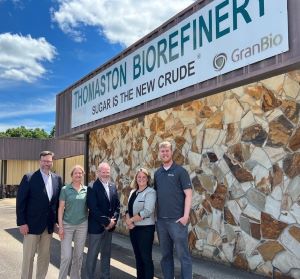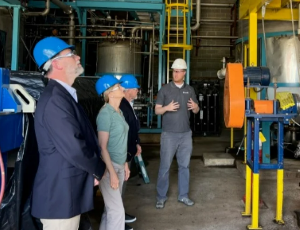 Mary Beth Cornell, Lawton Roberts and I had the pleasure to visit GranBio’s Thomaston Biorefinery located at three hundred Mcintosh Parkway, Thomaston, Georgia 30286.
Mary Beth Cornell, Lawton Roberts and I had the pleasure to visit GranBio’s Thomaston Biorefinery located at three hundred Mcintosh Parkway, Thomaston, Georgia 30286. Mary Beth Cornell, Lawton Roberts and I had the pleasure to visit GranBio’s Thomaston Biorefinery located at three hundred Mcintosh Parkway, Thomaston, Georgia 30286.
Mary Beth Cornell, Lawton Roberts and I had the pleasure to visit GranBio’s Thomaston Biorefinery located at three hundred Mcintosh Parkway, Thomaston, Georgia 30286.
Our hosts included Kim Nelson CTO, Cody Gallaher Plant Manager, Ryan Zebroski, R&D Director, and senior researchers Cosmas Bayuadri, Dongho Kim, and Shaobo Pan.
This elite group of professionals have been at this for many years now.
Their average tenure with GranBio, and predecessor American Process, is 11 years of service and their average within the biorefining and pulp and paper sectors is 21.
GranBio specializes in the development and commercialization of technologies to produce biofuels, biochemicals, and advanced materials like nanocellulose from biomass feedstocks including forest industry residues. The Thomaston Biorefinery, built in 2008, is a fully integrated pilot plant and R&D center to develop and demonstrate GranBio’s technologies. Since that time, they have developed a huge patent portfolio, a great deal of interest from investors and recently, were awarded a $80 million dollar grant. The grant is the largest ever from the DOE in the Bioenergy space, and will be used to build a 2 million USG/year sustainable aviation fuel (SAF) and renewable diesel demonstration plant from forest residues, in partnership with industrial behemoth Honeywell-UOP. This “cellulosic ethanol to jet” plant will start-up in early 2027 and will also produce wood-based sugars for production of biochemicals and nanocellulose.
The pulp and paper industry has shown considerable interest in hosting this “Enabling Net Zero” ENZ demonstration plant at an operating mill site GranBio is also evaluating shuttered P&P mill sites for their first commercial SAF plant. Over 160 pulp mills have been shuttered since 1995. Many companies are trying to repurpose these mills and diversify their product lines. One of GranBio’s plans is to convert some of these mills, hopefully ten, over the next 15 years to produce one billion gallons of sustainable jet fuel annually. The United States has a goal to produce 35 billion gallons SAF by 2050. The global need for Sustainable Jet Fuel is estimated to be 160 billion gallons by 2050.
In case you’re a cellulosic ethanol naysayer, there have been nine decades of cellulose ethanol production in the world. Since 1938, cellulosic ethanol has been continuously produced in sulfite pulp mills using pulping waste streams containing dissolved sugars.
 Today, four sulfite pulp mills produce a total of 26 MM GPY cellulosic ethanol along with cellulose pulp.
Today, four sulfite pulp mills produce a total of 26 MM GPY cellulosic ethanol along with cellulose pulp.
The other sulfite pulp mills worldwide could add approximately 60 MM GPY of additional cellulose ethanol capacity. Much more of this capacity is needed to supply the aviation sector with Ethanol-to-Jet Sustainable Aviation Fuel.
The new development: AVAP® American Value-Added Pulping.
(You need to know this………………….)
GranBio developed AVAP as an improvement to sulfite pulping chemistry to overcome sulfite’s low sugar yield that limits second-generation ethanol production capacity.
Like AVAP, sulphite pulping chemistry is based on sulfur dioxide (SO2). However, AVAP combines ethanol with SO2 to penetrate biomass rapidly during pulping, which preserves both the hemicellulose and cellulose for conversion to sugars and ethanol.
On the other hand, sulphite pulping, which does not contain ethanol, destroys approximately 30% of the hemicellulose sugars.
Advantages of AVAP for producing carbon neutral fuels and chemicals include:
High Sugar Yield- Nearly perfect sugar yield from biomass by preservation of cellulose and hemicellulose.
Feedstock Flexibility- Unique chemistry penetrates and fractions all forms of biomass, which has been proven at the Thomaston Biorefinery integrated pilot plant.
Low Enzyme Use- Efficient separation of hemicellulose and lignin from cellulose gives the lowest enzyme consumption in the industry. Enzymes are a major cost component for lignocellulose sugar production.
Chemical Recovery- Ethanol and sulfur dioxide are easily recovered and recycled in the process.
I am told that current aviation fuel has a carbon footprint of 89 gCO2e/MJ, while GranBio’s sustainable aviation fuel is 0-6 gCO2e/MJ, a 97-100% reduction. I don’t know about you but this is a huge WOW moment for our industry.
If you need more information or looking for collaboration, please contact Kim Nelson at +1 404-931-9109.
Remember there are two types of people in our industry, TAPPI members and those who should be. Until next time…Larry
TAPPI
http://www.tappi.org/